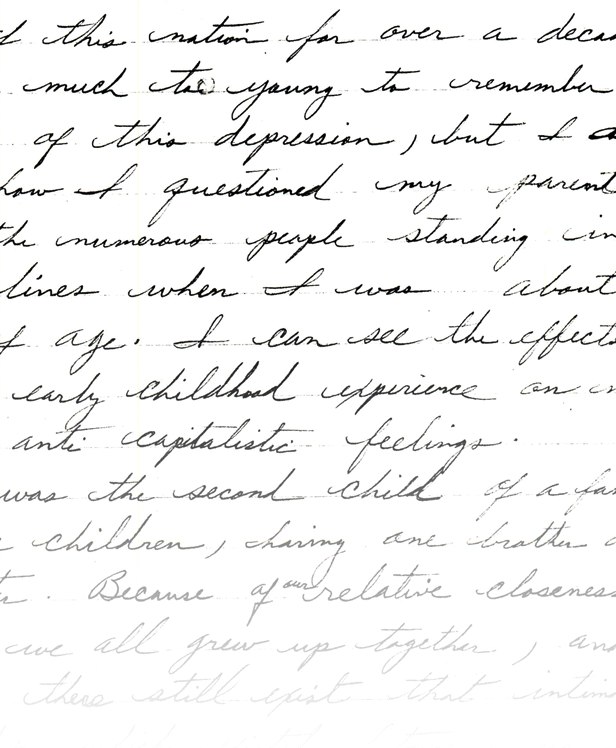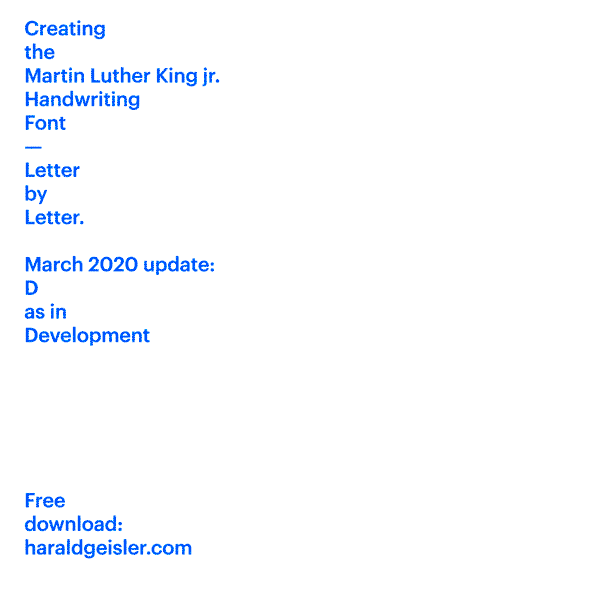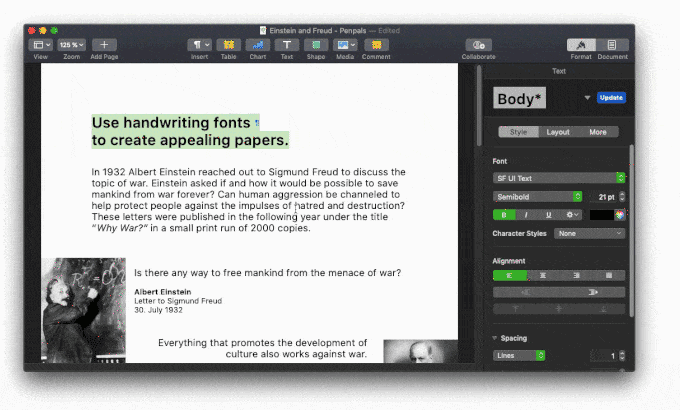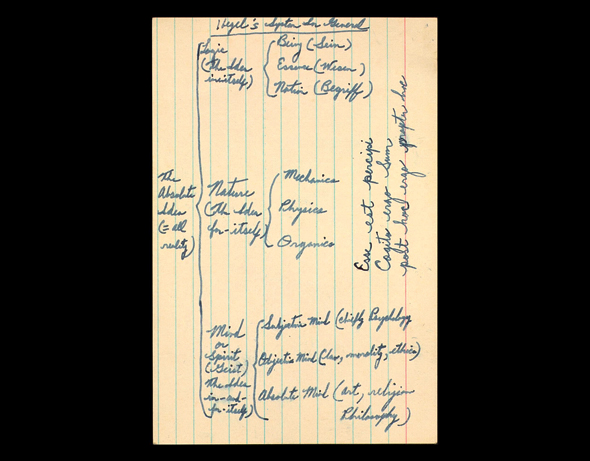Creating the Martin Luther King jr. Handwriting Font
Letter
by
Letter.
What does Dr. King’s handwriting look like?
The civil rights activist and minister’s speeches and actions resonated around the world and continue to inspire generations today. We all know what his voice sounds like, but as a typographer, I became curious: how did he prepare his speeches and organized his thoughts in writing, and what does Dr. King’s handwriting look like?
This project is about creating a font based on the handwriting of Martin Luther King. The font is free for private and educational use. It works on every PC, Mac, and mobile device.
A new letter every month… or more. The font has lowercase letters, and it is possible to write English texts. Uppercase letters, numbers, and signs are yet incomplete. New characters are added every month.
Witness the creation: Monthly, all users will receive an email with the updated font and videos showing and explaining the creation process.

How is the Martin Luther King handwriting font made?
The creation process is a unique method developed to focus on the movement of the writer on the paper. This process allows reproducing the letters exactly and captures the lively character of a hand.
In the first step, I analyze the pen’s path and place tangents along the letter. A Bezier curve aligning along the tangents recreates the writing movement. The trail then extends to represent the pressure applied through the pen. Finally, the drawing is then placed in the font and tested.
On the right, you see the creation of the letter “M“ and “z.”m The video plays 100 times faster than the original speed.
If you wish to read about the creation process in more detail, I have written an in-depth article →here.
The document is “An Autobiography of Religious Development.” An essay Dr. King wrote at the age of 22 for a course at Crozer Theological Seminary. Here he reviews the influences of his family and church on his religious beliefs. King recalls his first childhood confrontation with racism. The text is available through the Martin Luther King Papers

What will the Martin Luthed King font be based on?
My aim with handwriting font projects is to open the door to the content of an author through the aesthetic of handwriting and the general interest in typography and fonts. And with that, to create awareness for the cultural activity of writing and to imagine a creative vision for the future of writing in the 21st and 22nd century.
Creating a handwriting font requires samples of every (lower- and uppercase) letter of the alphabet. I select a variety of manuscripts that are representative of the author’s hand and are interesting and relevant to give an insight into the author’s body of work and time.
The central development of the font sources in “An Autobiography of Religious Development.“ An essay Dr. King wrote at the age of 22 for a course at Crozer Theological Seminary. Further texts are available through the Martin Luther King Papers Project at Stanford University.
But not all letters of the alphabet can be found there. So I am using a variety of other notes to complete the font. One of my personal favorites are these study notes Dr. King made about Hegel’s philosophy.
Current status of the font.
Since December 2023 the font development moved over to the digital handwriting font library → https://handwriting.digital
Who does the work?
Hi! My name is Harald Geisler. I am a typographer
Now, with the approval of the King Estate in Atlanta, I would like to continue the series and create a font based on Martin Luther King jr.’s handwriting.

Download the Martin Luther King Handwriting Font
Personal and educational use is free.
Since December 2023 the font development moved over to the digital handwriting font library → https://handwriting.digital
There you can download the Martin Luther King font for free to use it for personal and educational matters (non-commercial use).
Monthly you will receive an updated version of the font with more letters.
Donate
The creation process of the font is donation-driven. Making a handwriting font is a lot of work. I will add one letter to the font each month for free. On top of that, for each 100€ donated monthly, I will add one more letter to the font. The more people support the project, the faster everybody will receive a complete font.
I encourage you to donate monthly to the project. Even if it is a smaller amount, it helps the rhythm of the project.
Payments are processed through a credit card or PayPal. You can cancel and change your support at any time.
Funding Details
For transparency, I publicly show the total number of supporters and donations so that everybody involved knows how the project is doing. Please find a detailed spreadsheet →here.
How to use the font?
1. Download the font.
After checkout, you will receive an email. Here you will find links to download the file to use on your computer and another link to use the font on your iPhone / iPad. Please have a look in your Spam-folder, automated emails tend to go there.
2. Install the font.
Once the file is downloaded to your computer, you locate the font file on your disk and double-click it. Simply follow the instructions of your operating system to install the font.
If you are using the font on your iPhone or iPad, simply click the link in the email and follow the instructions on your phone.
Every month I will send you an update of the font with newly added letters.
3. Use the font
Everywhere you work with text, you can use the font. Once installed, the font is available in all your applications that support fonts. For example, Word, Office, or Pages.
For more information, have a look at this Helpful Font Guide – PDF on how to use and install fonts →here.
Below is an example of how to use handwriting fonts to create a paper:

History of the project
2014 in the context of the 50th anniversary of Dr. King’s visit to East Berlin (1964), I came upon a radio recording of a speech he gave in Marienkirche. I took note of the introduction because of what he says about his name:
“I come to you not altogether as a stranger, for the name that I happen to have, is a name so familiar to you, so familiar to Germany, and so familiar to the world. And I am happy, that my parents decided to name me after the great reformer.”
What influence is it on a person to grow up with a name linked to history? Is it a burden, or is it an inspiration to carry a name? For Martin Luther King jr, I imagine this connection must have been a source of inspiration.
With the handwriting fonts project, I am proposing a similar situation: What does it mean to write your thoughts and ideas with the “hand” of Dr. King, Luther, Einstein, or Freud? Is the author lurking over your shoulder as you write, or are you dictating, is the font a disguise or mask to hide behind, is it a role to switch into and to see and act as if you were, is it a challenging discussion on paper or an uplifting empowering writing together? I hope that these projects enrich your daily reading and writing experience and serve as a source of inspiration and a playful encounter with history.
Back in 2014, listening to the radio feature, I wrote Martin Luther King (1929-1968) on a board in my studio. A friend saw it and suggested then that I should create a Martin Luther (1483-1546) font first. I launched a successful Kickstarter campaign in 2017, the 500th anniversary of the Reformation.
In the Luther project description, you can read that I had planned to create the Dr. King font in 2018 commemorating the 50th anniversary of Dr. King’s assassination. But Luther’s half millennia-old handwriting occupied me longer than expected. After the campaign succeeded, scholars from different fields (Historians, Palaeographers, and Latin scholars) contributed freely to the documentation, expanding the work beyond what I had planned. These contributions gave the project new angles on the subject, which I value very much. I am curious to see how this project about Dr. King’s handwriting will develop and invite you to contribute and join this journey.
In 2019 I started a Kickstarter Campaign to finance the production costs at one time. The campaign fell short on October 26, which became the start of this website. Instead of crowdfunding the production all at once, this project works letter by letter.
Commercial use
Commercial use is not available to the public at the moment. You can contact Harald Geisler here.
Technical information
Format
The Martin Luther King font will be delivered in OpenType format with PostScript outlines. This format is standard and widely supported by all common operating systems like PC, Mac, Linux, iOS, Android, etc.
Features
Terminal forms (special letter variations at the end of a word)
Initial forms (specifically lowercase letters that are different at the beginning of a word)
Stylistic Sets (so you can pick which h you like better)
…and much more!
License
All fonts are licensed for private (non-commercial) and educational (in the context of your work as a teacher in a school or university) use.
EULA means End User License Agreement. Since a font is a design and software, we need to agree on many things, for example, what are my responsibilities and what can you expect from this software. You can read the EULA for all my fonts right here.
Language support Every language has specific needs; for example, in German, two dots are placed over vowels (ä,ö,ü) to indicate a modification.
Here is a list of the languages I am aiming to support:
Afrikaans, Albanian, Asu, Basque, Bemba, Bena, Bosnian, Catalan, Chiga, Congo Swahili, Cornish, Croatian, Czech, Danish, Dutch, Embu, English, Esperanto, Estonian, Faroese, Filipino, Finnish, French, Galician, German, Greek, Gusii, Hawaiian, Hungarian, Icelandic, Indonesian, Irish, Italian, Kabuverdianu, Kalaallisut, Kalenjin, Kamba, Kikuyu, Kinyarwanda, Lithuanian, Luo, Luyia, Machame, Makhuwa-Meetto, Makonde, Malagasy, Malay, Maltese, Manx, Meru, Morisyen, North Ndebele, Norwegian Bokmål, Norwegian Nynorsk, Nyankole, Oromo, Polish, Portuguese, Romansh, Rombo, Rundi, Rwa, Samburu, Sango, Sangu, Sena, Shambala, Shona, Slovak, Slovenian, Soga, Somali, Spanish, Swahili, Swedish, Swiss-German, Taita, Teso, Turkish, Vunjo, Zulu.
Update History

- February 14, 2024 📝 Martin Luther King Font Update #40 — February 2024
- January 14, 2024 📝 Martin Luther King Font Update #39 — January 2024
- November 3, 2023 📝 Martin Luther King Font Update #38 — November 2023
- August 18, 2023 📝 Martin Luther King Font Update #37 — August 2023
- May 9, 2023 📝 Martin Luther King Font Update #36 — May 2023
- April 5, 2023 📝 Martin Luther King Font Update #35 — April 2023
- March 8, 2023 📝 Martin Luther King Font Update #34 — March 2023
- January 17, 2023 📝 Martin Luther King Font Update #33 — January 2023
- November 17, 2022 📝 Martin Luther King Font Update #32 — November 2022
- September 17, 2022 📝 Martin Luther King Font Update #31 — September 2022
- August 5, 2022 📝 Martin Luther King Font Update #30 — August 2022
- June 21, 2022 📝 Martin Luther King Font Update #29 — June 2022
- April 29, 2022 📝 Martin Luther King Font Update #28 — April / May 2022
- April 9, 2022 📝 Martin Luther King Font Update #27 — April 2022
- March 3, 2022 📝 Martin Luther King Font Update #26 — March 2022
- January 20, 2022 📝 Martin Luther King Font Update #25 – Conversation Piece
- December 12, 2021 📝 Martin Luther King Font Update #24 – Dr. King in East Berlin
- October 25, 2021 📝 Martin Luther King Font Update #23 – October / November 2021
- October 9, 2021 📝 Martin Luther King Font Update #22 – October 2021
- August 28, 2021 📝 Martin Luther King Font Update #21 – September 2021
- August 7, 2021 📝 Martin Luther King Font Update #20 – August 2021
- June 30, 2021 📝 Martin Luther King Font Update #19 – July 2021
- June 1, 2021 📝 Martin Luther King Font Update #18 – June 2021
- May 17, 2021 📝 The next typography project: Creating a Handwriting Font Library and Contemporary Font Collection
- May 11, 2021 📝 Martin Luther King Font Update #17 – May 2021
- March 31, 2021 📝 Martin Luther King Font Update – March / April 2021
- February 28, 2021 📝 Martin Luther King Font Update – February / March 2021
- January 10, 2021 📝 Martin Luther King Font Update – January 2021
LICENSE GRANTED BY INTELLECTUAL PROPERTIES MANAGEMENT, ATLANTA, GEORGIA, AS EXCLUSIVE LICENSOR OF THE KING ESTATE.
